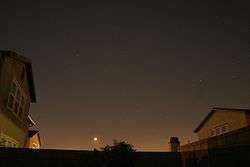Bortle scale
The Bortle scale is a nine-level numeric scale that measures the night sky's brightness of a particular location. It quantifies the astronomical observability of celestial objects and the interference caused by light pollution. John E. Bortle created the scale and published it in the February 2001 edition of Sky & Telescope magazine to help amateur astronomers evaluate the darkness of an observing site, and secondarily, to compare the darkness of observing sites. The scale ranges from Class 1, the darkest skies available on Earth, through Class 9, inner-city skies. It gives several criteria for each level beyond naked-eye limiting magnitude (NELM).[1] The accuracy and utility of the scale have been questioned in recent research.[2] The table below summarizes Bortle's descriptions of the classes. Some classes can have very drastic differences from the one next to it, e.g, Bortle 4 - 5.
| Class | Title | NELM | Approx. SQM[3] mag/arcsec2 |
Description | Color |
|---|---|---|---|---|---|
| 1 | Excellent dark-sky site |
7.6–8.0 | 21.7–22.0 |
|
Black |
| 2 | Typical truly dark site |
7.1–7.5 | 21.5–21.7 |
|
Gray |
| 3 | Rural sky | 6.6–7.0 | 21.3–21.5 |
|
Blue |
| 4 | Rural/suburban transition |
6.1–6.5 | 20.4–21.3 |
|
Green/Yellow |
| 5 | Suburban sky | 5.6–6.0 | 19.1–20.4 |
|
Orange |
| 6 | Bright suburban sky |
5.1–5.5 | 18.0–19.1 |
|
Red |
| 7 | Suburban/urban transition |
4.6–5.0 |
|
Red | |
| 8 | City sky | 4.1–4.5 | <18.0 |
|
White |
| 9 | Inner-city sky | 4.0 |
|
White |
See also

References
- Bortle, John E. (February 2001). "Gauging Light Pollution: The Bortle Dark-Sky Scale". Sky & Telescope. Sky Publishing Corporation. Retrieved 2020-05-29.
- Crumey, Andrew (2014). "Human Contrast Threshold and Astronomical Visibility". Monthly Notices of the Royal Astronomical Society. 442 (3): 2600–2619. arXiv:1405.4209. Bibcode:2014MNRAS.442.2600C. doi:10.1093/mnras/stu992.
- "Dark Skies Awareness".
External links
| Wikimedia Commons has media related to Light pollution. |